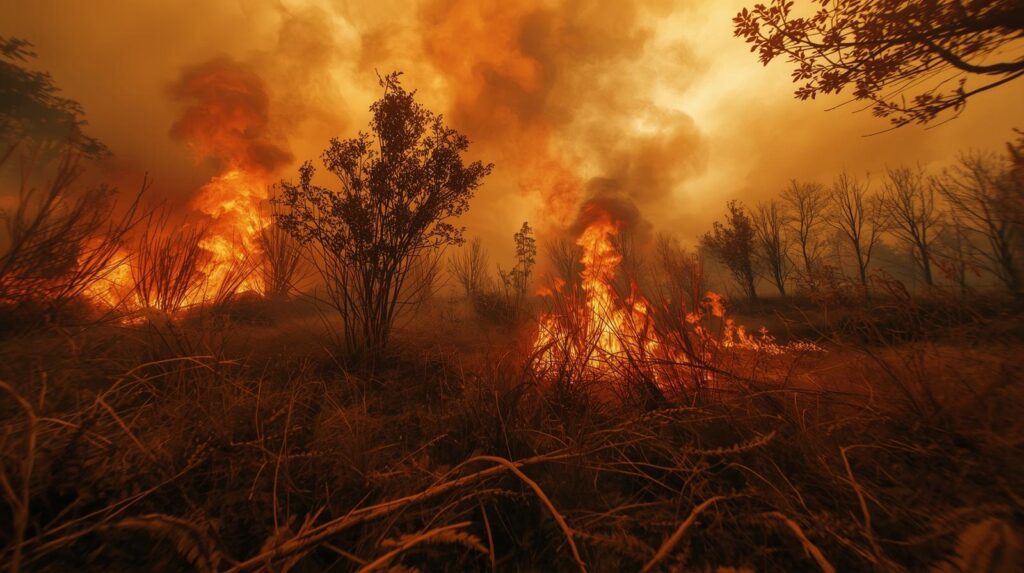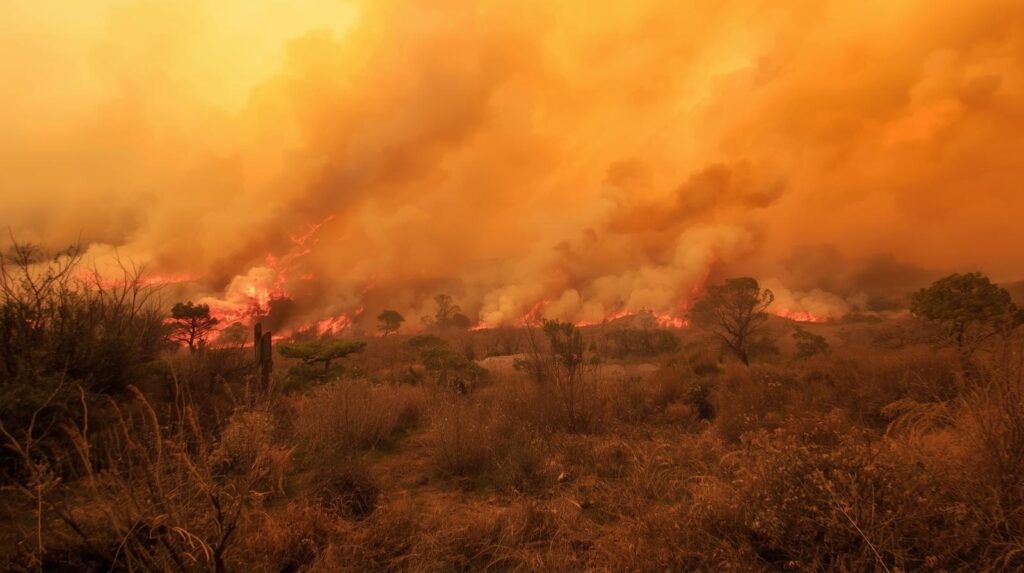Europe’s Wildfires: How Climate Change Is Turning Up the Heat
Wildfires have consistently erupted in Europe, particularly in warm southern regions where dry summers are the norm. But recently, these fires are expanding into something more frightening—enormous flames that sweep across forests, fields, and even villages. Imagine a summer evening in Spain or Greece: smoke hangs in the air, the sky glows red, and families scramble to safety. These aren’t just random events. The planet’s getting hotter because of things we do, like burning coal, oil, and gas, and it’s making wildfires bigger, fiercer, and harder to stop.
A Growing Fire Problem Across Europe
This year has been one of the worst for wildfires in Europe. Flames have scorched over a million hectares of land—an area bigger than some small countries. Spain and Portugal have been hit the hardest, with fires burning up forests, farms, and even national parks. In Spain, the land that was burned is almost four times more than it was in the 1980s and 1990s. Portugal’s losses are over double what they were decades ago. That amounts to houses reduced to ash, animals left with no place to call home, and air that is so smoky it’s difficult to breathe.
A couple of years ago, 2023 was a horrible year for fires with fires being among the largest in decades. But 2025 is proving even more disastrous, with already thousands of fires reported. Italy, Greece, Cyprus, Romania, and Turkey have all been hit by massive flames. In Greece, the tourists were forced to evacuate islands as fires raged on scorching heatwaves. In Cyprus, a single giant fire destroyed enormous tracts, though there weren’t as many fires total. The issue is expanding, reaching areas that infrequently experienced such intense fires previously.
Why Climate Change Is the Big Culprit
So, what’s behind these terrible fires? Climate change is the main culprit. When we use fossil fuels—such as gas for vehicles or coal for electricity plants—it emits gases that cause the air to trap heat. This heats the planet. Europe is warming at twice the rate of the rest of the world, with temperatures rising since the 1980s. Warmer summers and reduced rainfall make grass, bushes, and trees extremely dry. A small spark—perhaps from lightning or a careless campfire—can become a fire that spreads like a nightmare over the land.
The weather’s changing too. Hot, dry, windy days—the type of days that make fires spread quickly—are occurring more frequently. In Portugal and Spain, the climate that triggers recent fires is 40 times more likely to happen under current global warming conditions than it would have without the phenomenon. The conditions were previously uncommon, perhaps occurring once every several hundred years.

Nowadays, they may appear every 15 years or so. The fires are 30% hotter and spread faster due to the additional heat. In countries such as Greece and Turkey, the chances of fire-friendly weather have increased tenfold. Heatwaves, which were previously unheard of, are now a summer norm, desiccating lands and transforming forests into tinder.
Droughts and Winds: A Destructive Fire Storm
Droughts are exacerbating the situation. When it has not rained for months, vegetation and soil get dry, stockpiling fuel for fires. Powerful winds then spread the flames, blowing them over miles within hours. The temperature on Earth has increased by roughly 1.3 degrees Celsius since the pre-industrial era when factories and automobiles polluted the air.
That tiny difference is sufficient to advance the beginning of fire seasons—occasionally spring rather than summer—and extend them into autumn. Southern Europe is experiencing normal-length dry periods, paving the way for larger fires.
Where Fires Strike Most Severely
Let’s examine some of the most severely affected areas. Spain and Portugal, on the Iberian Peninsula, have been hit hard. More than 1% of their ground burned this year, including ancient paths and national parks. Temperatures topped 40 degrees Celsius in August, desiccating everything to a crispy brown. Spain’s fires alone emitted millions of tons of carbon dioxide—more than some nations emit in a year. Portugal lost close to 270,000 hectares in a matter of weeks, with fire spreading so quickly that firefighters couldn’t keep pace.
Greece has experienced its share of catastrophes as well. Fires drove people off islands and into the cities, including Athens. One fire spread so large that it engulfed all who attempted to quench it. Turkey and Albania have experienced the same disruptions, with fire encroaching on neighborhoods and villages. Even northern regions of Europe, such as central regions, are beginning to notice increased risk due to droughts expanding. If the earth is warmed 2 degrees Celsius, those areas may experience ten times more intense fires during dry periods.

A Vicious Cycle: Fires Intensify Warming
Here’s the frightening aspect: wildfires exacerbate climate change. When forests ignite, they release sequestered carbon as CO2, which warms the globe further. This year’s fires in Europe have released tens of millions of tons of CO2—imagine adding millions of cars onto the roads. Forests that are burned also have fewer trees left to absorb CO2, so the warming accelerates, causing drier ground and more fires. It’s a vicious circle. In addition, the smoke goes far, fogging up the air in regions such as France or the UK, and it becomes difficult for individuals to breathe, even several hundred miles away.
Human Decision-Making Pours Fuel on the Fire
It’s not all about the climate. Human activities contribute as well. In the countryside regions of the south and east of Europe, people are migrating, and fields and forests go uncultivated. Dead wood and overgrown bushes accumulate, just waiting to burn. With fewer youths to hang out, there’s less to clear the land or battle blazes. There are also homes in some places built too near the woods, placing more people at risk when fires erupt. Inadequate planning and a lack of maintenance allow fires to get out of control more easily.
The Heavy Toll on People and Nature
The cost to humans is heartbreaking. This year, at least four people died in fires in Spain and Portugal, and over a thousand others passed away from the intense heat. Thousands had to evacuate, leaving behind homes that sometimes burned to ash. Farmers lost crops, and tourists fled, hurting local businesses. In one Spanish fire, roads closed, cutting off supplies to towns. The pressure of losing all their possessions and having fires year after year weighs intensely in people’s minds.
Nature suffers as well. Mediterranean forests have adapted to some fire—it may even assist certain plants in their growth. But these fires today are too large and occur too frequently. They devastate species which cannot adapt quickly enough. Vulnerable animals lose their habitats, particularly in preserved parks. Trees hold soil in place; without them, rain carries it away, damming rivers and killing fish. It may take decades for ecosystems to recover, if they can at all in a warmer world.
Health and Economic Impacts
Wildfire smoke is an air pollutant. It contains minute particles that inflame lungs and hearts, leading to issues such as asthma or more severe problems. Wildfires are a leading cause of poor air days throughout Europe, impacting millions of people. Financially, the loss is enormous—billions of dollars spent fighting fires, in addition to the losses in agriculture and tourism. Cities that depend on tourists or crops are particularly hard-hit when fires deter visitors or burn crops.
What’s in Store for Europe’s Blazes?
Things may get more challenging, experts warn. If we continue to burn fossil fuels, record fires may increase by 14% globally by the year 2030. In Europe, warmer summers will continue to keep dangers high, particularly in the south and east. If warming reaches 2 degrees, even northern regions may see severe fire danger during droughts. Fire seasons could extend close to a year in some areas, with little time to rebound.

Fighting Back: Solutions and Hope
There is hope if we move. Nations are acting up. Greece has recruited additional firefighters and begun deploying drones to detect fires at their earliest stages. Spain is developing strategies to combat climate effects, such as conserving water and turning to renewable energy such as wind and sun. Prevention is the name of the game: remove unnecessary plants, plant fire-resistant trees, and conduct controlled burns to minimize fuel. Rotating crops with trees on farms can make the land less susceptible to burning.
We can help too. Refrain from lighting fires in times of dryness—hesitate over campfires or discarding cigarettes. Support those who lead to reduced pollution, such as using clean energy to reduce warming. Nations collaborating, such as sharing firefighter groups throughout Europe, is a huge step.
A Call to Action
Europe’s fires are a deafening warning. They illustrate how our behavior—consuming fossil fuels, abandoning land—is linked to the health of the planet. By learning how increasing heat and arid conditions ignite larger fires, we can understand the urgency of why we must move quickly. It is about safeguarding homes, preserving wildlife, and creating a safer world. Small steps can add up: recycle, conserve energy, vote for environmental policies. We can collectively cool things down and contain the fires.
